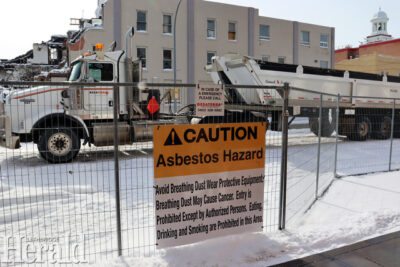Asbestos dangers addressed in safety regulations
By Al Beeber - Lethbridge Herald on March 9, 2023.
 Herald photo by Al Beeber
The City says it is working closely with Occupational Health and Safety as well as Alberta Environment to ensure that asbestos is being handled properly as crews work to demolish the old Lethbridge Hotel recently destroyed by fire.
Herald photo by Al Beeber
The City says it is working closely with Occupational Health and Safety as well as Alberta Environment to ensure that asbestos is being handled properly as crews work to demolish the old Lethbridge Hotel recently destroyed by fire.LETHBRIDGE HERALDabeeber@lethbridgeherald.com
Crews working to demolish the old Lethbridge Hotel face an unseen but present danger.
That danger, asbestos, is long known to be a cause of cancer and as work progresses, the City is working closely with Occupational Health and Safety as well as Alberta Environment to ensure that substance is being handled properly.
Alberta’s Occupational Health and Safety Code has various requirements that need to be followed when working in environments with the presence of asbestos.
First, employers must ensure all people working with asbestos receive the training that’s necessary to do the work safely.
All workers must also get asbestos training from a government-approved agency before handling the substance in a restricted area.
All employers who are responsible for removing or abating asbestos, or for demolishing or renovating a building (or equipment) containing asbestos are required to give Alberta OHS 72 hours notice before starting work that could release asbestos fibres.
Before 1990, according to a Government of Canada website, asbestos was mostly used for insulating buildings, including homes against cold weather and noise as well as for fireproofing. The government says the manufacture, import, sale and use of products containing asbestos is prohibited in the country.
But it can still be found in building materials such as cement and plaster, floor and ceiling tiles, house sidling, tar paper, shingles and felt as well as paint, drywall, putty, caulking, sparkling and sealants.
Asbestos fibres or dust can be inhaled during renovations and demolition activities, says the federal government.
Asbestos, says a 174-page 2019 Government of Alberta asbestos abatement manual on asbestos, is effective as a reinforcing or binding agent when combined with plastic or cement and has properties of value including strength and flexibility when separated into fibre and incombustibility.
Alberta OHS changes are scheduled to come into effect on March 31.
Some products that could contain asbestos are on building exteriors such as asbestos-cement siding panel, asbestos-cement soffits and roof panels and roofing felts and mastics.
It can also be used as insulation in boiler rooms, fan rooms, crawl spaces, machine rooms, wall cavities, above ceiling spaces as well as insulation block and sprayed insulation. Vermiculite insulation may contain tremolite asbestos as a contaminant, says the manual. It can also be used in steam and hot water heating supply and return lines, chilled water lines and domestic water supply and drain lines.
The manual, which is to be updated, said asbestos has to be inhaled to cause disease and that intact and undisturbed asbestos “presents no direct health hazard but does present a potential exposure hard if fibres are released and inhaled…the health risk is considered minimal for asbestos materials in good condition, in an inaccessible location and protected from damage.”
The dangers of asbestos, says the manual, were recognized when Pliny the Elder in the first century AD wrote of a sickness in the lungs of slaves who were involved in the process of weaving asbestos cloth.
“Asbestosis was first identified in 1930 but the cancer-producing potential of asbestos was not established until 1949. That year a report described higher than normal percentages of lung cancer among individuals dying from asbestosis. It was not until 1960 with the publication of a series of cases in South Africa, that the association between malignant pleural mesothelioma and asbestos exposure was generally recognized.”
Asbestosis is an irreversible and sometimes fatal disease. It’s said to be similar to silicosis and black lung.
Work sites where there is a reasonable chance the airborne concentration of asbestos exceeds the occupational exposure limit are considered to be hazardous sites.
Employers must ensure workers at sites use or wear equipment required by provincial legislation, are competent and familiar with work procedures and competent in the use, maintenance, applications and limitations of equipment, including protective. They must also have adequate training in the safe operation of equipment.
Follow @albeebHerald on Twitter
22-21


